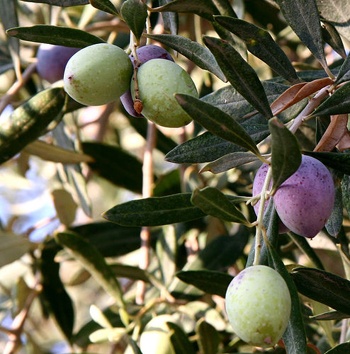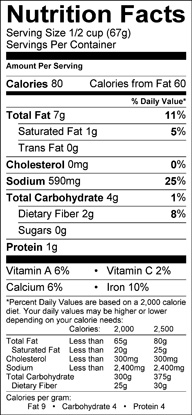Contents:
Common Names | Parts Usually Used | Plant(s) & Culture | Where Found | Medicinal Properties | Biochemical Information
Legends, Myths and Stories | Uses | Formulas or Dosages | Nutrient Content | How Sold | Warning | Resource Links | Bibliography
Scientific Names

- Olea europaea L.
- Olive family
Common Names
- Olive fruit
- Olive tree
Parts Usually Used
Leaves, bark, fruit
Back to Top

Description of Plant(s) and Culture
The olive tree is an evergreen; the hard, yellow wood of the gnarled trunk is covered by gray-green bark; the branches extend to a height of 25 feet or more. The opposite, leathery leaves are elliptic, oblong, or lanceolate in shape; they are dark green on top and have silvery scales beneath. The fragrant white flowers grow in axillary panicles that are shorter than the leaves. The fruit is an oblong or nearly round drupe which is shiny black when ripe.
Back to Top
Where Found
Native to the Mediterranean area but widely grown in tropical areas and warm climates.
Back to Top
Medicinal Properties
Leaves: antiviral, antiseptic, antispasmodic, astringent, febrifuge, tranquilizer, vasodilator and they lower blood pressure
Oil: cholagogue, demulcent, emollient, laxative, nutritive
Back to Top
Biochemical Information
Pure olive oil contains 2% saturated fats, 2% polyunsaturated fats, and 10% monosaturated fats
Fatty oil, with linoleic, oleic, palmitic, stearic and arachidic acids; also small amounts of free fatty acids, phytosterin, enzymes, bitter principle, pigment and a trace of lecithin
Back to Top
Legends, Myths and Stories
Pure virgin olive oil helps reduce serum cholesterol. A monosaturated acid-rich diet that includes olive oil may be the reason for the low cholesterol plasma levels found in Italy and Greece. Best of all, lowering cholesterol levels with natural products that have no side-effects is, by some people’s opinion, better than taking cholesterol-lowering drugs that may trigger other conditions such as psoriasis or worsen it, or have far worse side-effects, some of which are still unknown. Scientific studies in France, Yugoslavia and elsewhere have shown that daily doses of olive oil can effectively reduce blood cholesterol.
In the prehistoric Neolithic period, men in the Near East and the eastern Mediterranean area were already cultivating the olive tree, mainly for its oil. Since then, olive oil has served primarily as a food, but also as a fuel for lamps, as medicine, as an emollient for dry skin, and as an anointing oil for religious purposes. In many countries, from the Orient to the Mediterranean, the olive has been a symbol of peace and wealth. It is also regarded as a sign of safe travel, from the biblical accounts of the dove’s bringing back an olive leaf to Noah on Mount Ararat to indicate that the waters of the flood had nearly subsided.
According to Greek myth, the goddess of wisdom, Athene, taught men the use of the olive tree. Both Athene and Poseidon, the god of the sea, wanted to be the patron of Attica, the section of Greece that includes the city of Athens. The other gods on Mount Olympus devised a contest for them, specifying that the winner would be the one who could provide the best gift to the people of Attica. Poseidon struck the ground with his trident, and a horse sprang forth; Athene did likewise with her spear, and an olive tree grew up. The gods decided that the olive, as a symbol of peace and agriculture, was a much better gift than Poseidon’s horse, a symbol of war. So Athene became the patron of Attica, and its principal city was named after her. Hardly by coincidence, Attica was the number one producer of olives in all of Greece.
Olive trees are known to live a long time, some well over a thousand years. It is claimed that some olive trees growing in the garden of Gethsemane date back to the time of Christ. Olive oil is similar to sesame seed oil.
Since biblical times, the olive branch has been a symbol of peace and prosperity.
Back to Top
Uses
A decoction of Olive leaves or inner bark of the tree is effective against fever, mild tranquilizer, and treats stomach ulcers. An infusion of the leaves has a tranquilizing effect helpful for nervous tension and lower blood pressure by dilating blood vessels. Olive oil taken internally increases secretion of bile and acts as a laxative by encouraging muscular contraction in the bowels and is reported to be a good preventative of gallstones or to help in the eviction of the gallstones. Relieves constipation. It is also soothing to mucous membrane and is said to dissolve blood cholesterol. Olive oil is high in monounsaturated fats, and has the ability to reduce the “bad” cholesterol (LDL) in the blood without reducing the good cholesterol (HDL). Studies show that a diet high in olive oil will result in a lower incidence of heart disease, rather than those who eat diets high in other forms of fat. (To prevent heart disease, nutritionists recommend limiting daily intake of fat calories to 30% of total daily caloric intake, and 10% to 15% of that should be monounsaturates such as olive oil. Olive oil is useful externally for burns, bruises, insect bites, sprains, bursitis, dry scalp, dry hair, and intense itching (pruritus). With alcohol it makes a good hair tonic, and with oil of rosemary a good treatment for dandruff. One of its most common uses is as a base for liniments and ointments. Olive oil enters into the manufacture of cosmetics, toilet soaps, hair preparations, shampoos, and skin lotions.
Back to Top
Formulas or Dosages
Infusion: steep 1 to 2 tsp. leaves in 1 cup water for 10 minutes. A dose is 2 tsp. or a mouthful several times per day.
Decoction: boil 2 handfuls leaves or bark in 1 qt. water until 1 cup liquid remains.
Oil: as a laxative, take 1 to 2 fl. oz. straight-up per day, as a cholagogue, take 1 to 2 tsp. at a time.
To reduce cholesterol (LDL), substitute 1 to 2 tbsp. of olive oil for other fat in cooking or as salad oil daily.
Back to Top
Nutrient Content
Fats, carbohydrates, iron, and vitamin E

How Sold
Ripe olives, stuffed olives, and pure olive oil can be obtained in any supermarket
Back to Top
Warning
Do not use as a laxative during pregnancy.
Back to Top
Resource Links
Bibliography
![]() The Herbalist Almanac
The Herbalist Almanac, by Clarence Meyer, Meyerbooks, publisher, PO Box 427, Glenwood, Illinois 60425, copyright 1988, fifth printing, 1994
 Earl Mindell’s Herb Bible
Earl Mindell’s Herb Bible, by Earl Mindell, R.Ph., Ph.D., Simon & Schuster/Fireside, Rockefeller Center 1230 Avenue of the Americas, New York, New York 10020
![]() The Herb Book
The Herb Book, by John Lust, Bantam Books, 666 Fifth Avenue, New York, NY. copyright 1974.
![]() Indian Herbalogy of North America
Indian Herbalogy of North America, by Alma R. Hutchens, Shambala Publications, Inc., Horticultural Hall, 300 Massachusetts Avenue, Boston, Massachusetts 02115, 1973
 The Magic of Herbs in Daily Living
The Magic of Herbs in Daily Living, by Richard Lucas, Parker Publishing Co. (1988).
![]() The Nature Doctor: A Manual of Traditional and Complementary Medicine
The Nature Doctor: A Manual of Traditional and Complementary Medicine, by Dr. H.C.A. Vogel; Keats Publishing, Inc., 27 Pine Street (Box 876) New Canaan, CT. 06840-0876. Copyright Verlag A. Vogel, Teufen (AR) Switzerland 1952, 1991
![]() Prescription for Nutritional Healing, Fifth Edition: A Practical A-to-Z Reference to Drug-Free Remedies Using Vitamins, Minerals, Herbs & Food Supplements
Prescription for Nutritional Healing, Fifth Edition: A Practical A-to-Z Reference to Drug-Free Remedies Using Vitamins, Minerals, Herbs & Food Supplements, by James F. Balch, M.D. and Phyllis A. Balch, C.N.C., Avery Publishing Group, Inc., Garden City Park, NY
![]() Planetary Herbology
Planetary Herbology, by Michael Tierra, C.A., N.D., O.M.D., Lotus Press, PO Box 325, Twin Lakes. WI 53181., Copyright 1988, published 1992
 Secrets of the Chinese Herbalists
Secrets of the Chinese Herbalists, by Richard Lucas, Parker Publishing Company, Inc., West Nyack, NY, 1987.
![]() The Yoga of Herbs: An Ayurvedic Guide to Herbal Medicine
The Yoga of Herbs: An Ayurvedic Guide to Herbal Medicine, by Dr. David Frawley & Dr. Vasant Lad, Lotus Press, Twin Lakes, Wisconsin, Second edition, 1988.
![]() Webster’s New World Dictionary
Webster’s New World Dictionary, Third College Edition, Victoria Neufeldt, Editor in Chief, New World Dictionaries: A Division of Simon & Schuster, Inc., 15 Columbus Circle, New York, NY 10023
